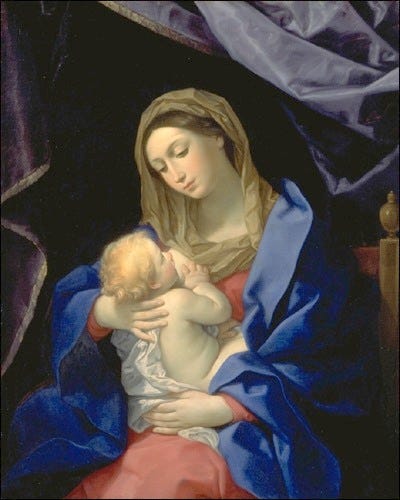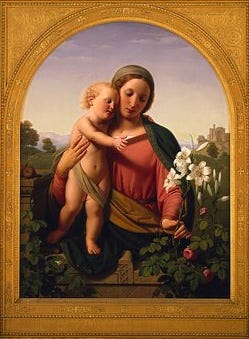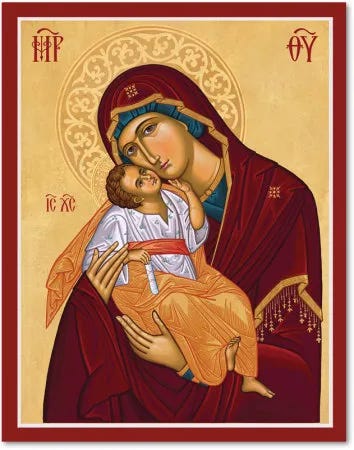A Blessed Feast of Our Lady of La Leche or Feast of the Divine Maternity of Mary
We have concluded our Novena for the intercession of Our Lady of La Leche, Patroness of Florida for the defeat of Amendment 4 in Florida, the consecration of Florida to the Sacred Heart of Jesus, and the protection and recovery of all those afflicted by recent storms.
We pray you have had the opportunity to enjoy this most beautiful Feast of Our Lady.
Mary bore a mute Babe
though in Him were hidden all our tongues.
Joseph carried Him,
yet hidden in Him was a silent nature older than everything.
The Lofty One became like a little child,
yet hidden in Him was a treasure of Wisdom that suffices for all.
He was lofty
but He sucked Mary's milk,
and from His blessings all creation sucks.
He is the Living Breast of living breath;
by His life the dead were suckled, and they revived.
Without the breath of air no one can live;
without the power of the Son no one can rise.
Upon the living breath of the One Who vivifies all
depend the living beings above and below.
As indeed He sucked Mary's milk,
He has given suck -- life to the universe.
As again He dwelt in His mother's womb,
in His womb dwells all creation.
Mute He was as a babe,
yet He gave to all creation all His commands.
For without the First-Born no one is able to approach Being,
for He alone is capable of it.
St. Ephraem's Hymns on the Nativity
The object of this feast is to commemorate the dignity of the Mary as Mother of God. Mary is truly the Mother of Christ, who in one person unites the human and divine nature. This title was solemnly ratified by the Council of Ephesus, 22 June, 431. The hymns used in the office of the feast also allude to Mary's dignity as the spiritual mother of men. The love of Mary for all mankind was that of a mother, for she shared all the feelings of her son whose love for men led Him to die for our redemption (Hunter, Dogm.Theo. 2, 578). The feast was first granted, on the petition of King Joseph Manuel, to the dioceses of Portugal and to Brasil and Algeria, 22 January, 1751, together with the feast of the Purity of Mary, and was assigned to the first Sunday in May, dupl. maj. In the following year both feasts were extended to the province of Venice, 1778 to the kingdom of Naples, and 1807 to Tuscany. At present the feast is not found in the universal calendar of the church, but nearly all diocesan calendars have adopted it. In the Roman Breviary the feast of the Maternity is commemorated on the second, and the feast of the Purity on the third, Sunday in October. In Rome, in the Church of S. Augustine, it is celebrated as a dupl. 2. classis with an octave, in honour of the miraculous statue of the Madonna del Parto by Sansovino. This feast is also the titular feast of the Trinitarians under the invocation of N. S. de los Remedios. At Mesagna in Apulia it is kept 20 February in commemoration of the earthquake, 20 February 1743.1
In the sixteenth century, even amidst their many divergences, the so-called Reformers agreed in utterly rejecting all the honors paid by the Catholic Church to the Blessed Virgin Mary, on the grounds that such veneration of the Mother detracted from the supreme worship due to her Divine Son. Four centuries have more than sufficed to show the result of so doing: the Son has followed the Mother! The descendants of those who refused to Mary the title and rights of Theotokos –Mother of God—refuse to Jesus the title of Son of God in the traditional sense of the term. Many reject His Godhead altogether, placing Him merely at the head of the line of great moral and social world-teachers; others still retain the word “divinity” with respect to Him, but for them it is no longer synonymous with “deity.”
Holy Scripture tells us that those who first came to adore Him Who is Son of God and Son of Mary found Him “with Mary his Mother.” At the scene of the first miracle at Cana, which marked the opening of his public life, “the Mother of Jesus was there.” In the tremendous hour when all was consummated, when types and shadows gave place to the mighty reality, “there stood by the Cross of Jesus His Mother.” And when the little flock who were to be the nucleus of the Church of God awaited in prayer the coming of the Paraclete, Who would teach them all truth, again it was in company with “Mary the Mother of Jesus.” Far from taking from the honor and love due to the Word Incarnate, devotion to Mary is a strong bulwark protecting the central doctrine. He is ever found with His Mother; where Mary is denied her rights, sooner or later Jesus is denied His; they stand or fall together.
This was realized in the year 431 when, at the General Council of Ephesus, the Church condemned the Nestorian heresy, whereby the Patriarch of Constantinople, Nestorius, had taught that, since in Christ there are two persons, a Divine and a human, Mary was mother only of the Man “Christ”, and therefore could not be called “Mother of God.” He therefore denied “that wondrous and substantial union of the two natures which we call hypostatic.”
On the occasion of the fifteenth centenary of the Council of Ephesus, the Sovereign Pontiff, Pius XI, issued the Encyclical Lux Veritatis (link added by SF, note: Lux Veritatis was written in 1931)) recalling the history of the heresy and commenting thus upon the dogma of the hypostatic union: “When once the doctrine of the hypostatic union is abandoned, whereon the dogmas of the Incarnation and of man’s Redemption rest and stand firm, the whole foundation of the Catholic religion falls and comes to ruin. . . . When once this dogma of the truth is securely established, it is easy to gather from it that, by the mystery of the Incarnation, the whole aggregate of men and of mundane things has been endowed with a dignity than which certainly nothing greater can be imagined, and surely grander than that to which it was raised by the work of creation.”
Proceeding to speak of the special dignity of the Blessed Virgin Mary, the Pope emphasizes that, “because she brought forth the Redeemer of mankind, she is also in a manner the most tender Mother of us all, whom Christ our Lord deigned to have as His brothers; wherefore we may confidently entrust to her all things that are ours, our joys, our troubles, our hopes; especially if more difficult times fall upon the Church —–if faith fail because charity has grown cold, if private and public morals take a turn for the worse.”
In this last connection we are reminded of another result of the loss of devotion to the Mother of God. Frequently and truly we hear and speak of the “paganism” of the present age. The decay of faith has been followed inevitably by a decline in morality, and our elaborate and complex civilization is threatened with the dissolving agent which contributed in no small measure to the overthrow of the magnificent civilization of old Rome: namely, the loss of the domestic virtues, the disappearance of healthy, normal family life, consequent upon the abandonment of the Christian ideals of marriage and parenthood.
It is a truism that one of the greatest social effects of Christianity was to raise the status of womanhood. Her legal position in the Ancient World was little better than that of a slave, and although classical literature furnishes us with examples of women who, in pagan homes, yet enjoyed high honor and affection, such are few indeed, and but serve to prove the rule. Divorce, infanticide, general degradation of womanhood, and not infrequently of childhood, were accepted features of pagan social order. The ideal and model of the “new woman ” of the Christian dispensation was the Mother of God. It was Mary, “Mother of fair love,” “Madonna,” “our Lady,” who ennobled the degenerate old civilization, just as she tamed the fierce barbarian peoples; she it was who inspired the ideals of the later chivalry. In Mary, all her sex was uplifted; in her motherhood all motherhood became blessed. Now again the world needs the hallowing influence of the Mother of God and of men, if “the life of the family, the beginning and the foundation of all human society” is to be preserved in all its nobility and its purity.
Desirous “to mark the commemoration, and help to nourish the piety of clergy and people towards the great Mother of God,” His Holiness concludes the Encyclical by establishing the new feast of the Divine Motherhood, to be celebrated on October 11 by the universal Church.The Liturgical Year
~ Dom Prosper Gueranger
https://www.newadvent.org/cathen/10046a.htm






